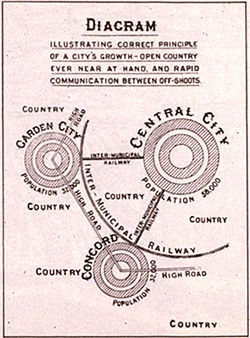Garden city movement


The garden city movement is an approach to urban planning that was founded in 1898 by Sir Ebenezer Howard in the United Kingdom. Garden cities were to be planned, self-contained communities surrounded by greenbelts, and containing carefully balanced areas of residences, industry, and agriculture.
Inspired by the Utopian novel Looking Backward, Howard published To-morrow: a Peaceful Path to Real Reform in 1898 (reissued in 1902 as Garden Cities of To-morrow), organized the Garden City Association in 1899. Two cities were founded based on Howard's ideas: Letchworth Garden City and Welwyn Garden City, both in England.
Howard's successor as chairman of the Garden City Association was Sir Frederic Osborn, who extended the movement into regional planning. [1]
The idea of the garden city was influential in the United States (in Newport News, Virginia's Hilton Village; Pittsburgh's Chatham Village; Sunnyside, Queens; Radburn, New Jersey; Jackson Heights, Queens; the Woodbourne neighborhood of Boston; Garden City, New York; Forest Hills, NY, and Baldwin Hills Village in Los Angeles), in Canada (in Kapuskasing, Ontario and Walkerville, Ontario) and in Argentina (in ciudad jardín de Lomas del Palomar). The first German garden city, Hellerau, a suburb of Dresden, was founded in 1909. The concept was drawn upon for German worker housing built during the Weimar years, and again in England after World War II when the New Towns Act triggered the development of many new communities based on Howard's egalitarian vision. Scandinavian examples include the garden city of Bromma in Stockholm, built 1910-1940, including the internationally acclaimed functionalist garden city area of Södra Ängby. The garden city movement also influenced the Scottish urbanist Sir Patrick Geddes in the planning of Jerusalem's expansion and Tel-Aviv, Israel in 1920's during the British mandate period. Contemporary town planning charters like New Urbanism and Principles of Intelligent Urbanism find their origins in this movement. Today, there are many garden cities in the world. Most of them, however, exist as just dormitory suburbs, which completely differ from what Howard wanted to create.
The Town and Country Planning Association recently marked its 108th anniversary by calling for Garden City and Garden Suburb principles to be applied to today's New Towns and Eco-towns.
See also
- Car culture
- Colonel Light Gardens, South Australia
- Ebenezer Howard
- New Urbanism
- Bedford Park, London
- Milton Keynes
- Ciudad Jardín Lomas del Palomar, Buenos Aires
- Charles Reade (town planner)
- Transit Oriented Development
- Tapiola
- Telford
- Transition Towns
- European Urban Renaissance
- Hellerau
- Principles of Intelligent Urbanism